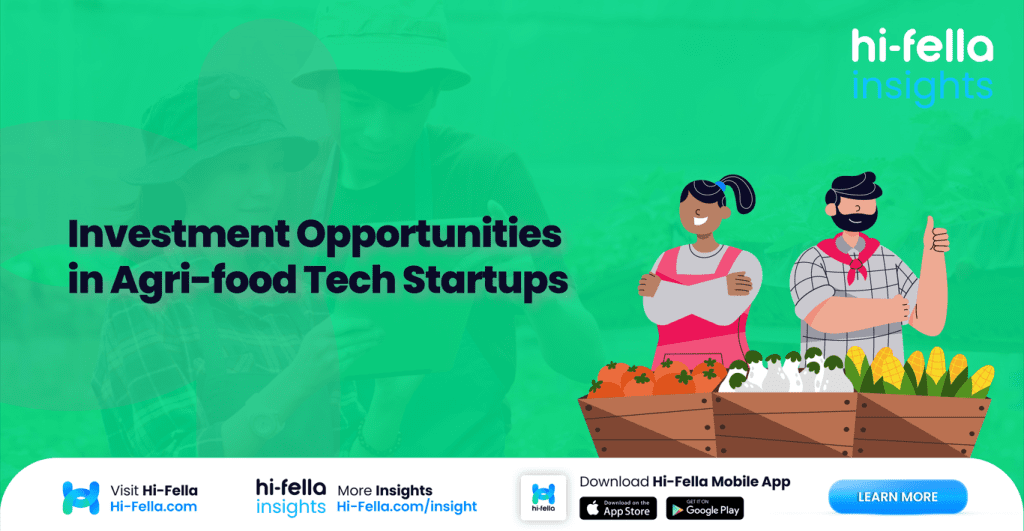The agri-food tech sector is no longer the hidden corner of venture capital. It’s the frontier. The convergence of food production, biotechnology, sustainability, and data science has opened a fertile ground for investors. From vertical farms to cultured meat, from AI-powered crop management to blockchain-enabled food traceability—agri-food tech is where global challenges meet disruptive innovation. And that, naturally, spells opportunity.
Why Agri-food Tech Matters Now More Than Ever
Let’s set the stage. The global population is expected to reach nearly 10 billion by 2050. That’s a 25% increase in mouths to feed—without a 25% increase in arable land. Climate change is messing with growing seasons, water scarcity is biting hard, and traditional agriculture systems are stretched thin.
Cue agri-food tech. This isn’t just about farming smarter. It’s about transforming the entire food supply chain—from seed to shelf, soil to software. For investors, this sector doesn’t just tick the box of profitability—it answers the call of global necessity.
The Core Segments of Agri-food Tech Startups
Agri-food tech is a wide universe. Here are the key sectors where startups are rethinking how we grow, distribute, and consume food:
Alternative Proteins
Startups in this space are developing meat and dairy alternatives using plants, fungi, or cultured cells. Think of Beyond Meat, Impossible Foods, and the emerging wave of precision fermentation startups creating proteins without animals. The demand? Massive. The environmental upside? Game-changing.
Vertical and Urban Farming
Using hydroponics, aeroponics, and controlled environments, startups are growing leafy greens and herbs in cities, warehouses, even shipping containers. It’s fresh, hyper-local, and significantly reduces water usage and food miles. Companies like Plenty and Infarm are already making serious waves.
Farm Robotics and Automation
Robots that weed, drones that plant, AI that predicts disease outbreaks. The future farm is high-tech, and startups are providing the tools. The goal? Reduce labour dependency, maximise yields, and bring precision to every aspect of farm operations.
Agri-biotech and Soil Innovation
From CRISPR-edited crops that resist drought to microbes that boost soil health, biotechnology is rewriting the rules of what’s possible in agriculture. These innovations target sustainability, productivity, and resilience in the face of climate volatility.
Food Waste and Supply Chain Innovation
Roughly one-third of all food produced is wasted. Startups are tackling this with software that optimises inventory, logistics tech that improves shelf life, and even upcycling food waste into new ingredients. The waste problem is massive—and so is the opportunity to solve it.
Traceability and Food Transparency
Consumers today want to know the story behind their food. Blockchain and IoT-powered solutions are giving unprecedented transparency into how food is grown, handled, and delivered. That trust translates into brand loyalty—and it’s a compelling value proposition for the right tech stack.
Investment Trends and Deal Flows
Venture funding in agri-food tech hit record highs in the last five years, particularly in North America, Europe, and parts of Asia. While the market cooled slightly after the 2021 surge, it’s still robust, especially in early-stage funding rounds.
Growth is now more measured, with VCs favouring companies that have a clear path to profitability, scalable tech, and strong ESG credentials. Strategic investors—from agri-giants to food conglomerates—are also getting in the game, either through direct investments or partnerships.
What’s worth noting is the growing interest in climate-aligned investing, where agri-food tech fits squarely. Funds focused on impact, decarbonisation, and regenerative agriculture are actively scouting for startups in this space.
Geographic Hotspots to Watch
While Silicon Valley continues to lead the way with tech-driven agri-food investments, innovation in this space is rapidly decentralising. A growing number of countries are becoming key players, each bringing unique strengths, market conditions, and government backing to the table. For investors, looking beyond the usual suspects could open the door to emerging founders, new markets, and untapped technologies.
1. Netherlands
The Netherlands punches far above its weight in the agri-food world. Despite its small size, it’s the world’s second-largest agricultural exporter—thanks to its advanced greenhouse systems, sustainable practices, and innovation hubs like Wageningen University. Dutch startups are leading the charge in vertical farming, climate-resilient seeds, and controlled-environment agriculture. The ecosystem benefits from tight integration between academia, government, and private sector, making it an attractive location for agri-tech pilots and partnerships. With the country’s focus on sustainable intensification and high yields on limited land, it’s a goldmine for investors eyeing scalable solutions.
2. Singapore
Singapore is emerging as Southeast Asia’s agri-food tech capital—not because of farmland (it barely has any), but because of strategic intent. With food security being a national concern, the government launched the “30 by 30” initiative, aiming to produce 30% of the country’s nutritional needs locally by 2030. This has resulted in major funding rounds for startups in urban farming, cultured meat, and food traceability. Supportive regulation, public-private grants, and regional market access make it a launchpad for companies targeting Asia’s growing middle class. Singapore is especially hot for investors looking to fund the next unicorn in alternative protein or agri-biotech.
3. India and Africa
India and parts of Sub-Saharan Africa present massive, underexplored opportunities in agri-fintech, yield optimisation, and digital infrastructure for smallholder farmers. In India, startups are leveraging mobile platforms, satellite data, and micro-lending to improve productivity for a farming population that spans over half a billion people. Meanwhile, African nations like Kenya, Nigeria, and Ghana are rapidly adopting tech solutions to combat inefficiencies in farming, logistics, and market access. Both regions face challenges—fragmented markets, policy barriers, limited infrastructure—but they also offer scale and impact at a level few other markets can match. For investors with patience and a long-view, the ROI potential—financial and social—is significant.
Risk Factors to Consider
Let’s be clear—this sector isn’t without risk. Regulatory hurdles (especially in biotech and alt-protein), long R&D cycles, and capex-heavy models in farming tech can delay ROI. Some consumer adoption trends are also still evolving.
But here’s the key: these aren’t speculative moonshots. The demand for food security, climate resilience, and supply chain transformation is persistent and real. With due diligence and a long view, the risk-reward equation remains attractive.
Exit Opportunities: IPOs, Acquisitions, and Strategic Plays
Exit strategies are maturing. Several agri-food tech companies have gone public or been acquired by food majors. For example, Nestlé, Tyson Foods, and Unilever have snapped up startups in everything from plant-based meat to supply chain tech.
There’s also increasing appetite from SPACs and sustainability-focused ETFs. The strategic value of these startups—whether to improve sustainability scores, unlock new product lines, or hedge against supply shocks—makes them hot targets.
What to Look for in a Winning Agri-food Tech Startup
If you’re scanning the field, here’s what to keep your eyes on:
- Scalability – Can the tech be applied across regions or categories?
- Differentiation – Is it doing something meaningfully better, faster, or cheaper?
- Founding Team – Do they understand both tech and agriculture? The agri-tech divide is real.
- Business Model Fit – B2B, B2C, or B2B2C? Understand the go-to-market path and monetisation strategy.
- Regulatory Roadmap – Especially in alt-protein or biotech, this can make or break a timeline.
You’re not just betting on tech. You’re betting on timing, regulation, global macro trends—and a startup’s ability to navigate all of them.
The Bigger Picture: Why This Sector Deserves Your Portfolio’s Attention
Food is foundational. It’s not optional, not cyclical, and not replaceable by the next shiny consumer trend. Investing in agri-food tech is a play on planetary resilience, demographic inevitability, and scientific progress. It’s also a hedge against a broken system—and a shot at helping fix it.
So whether you’re a seasoned investor, a corporate strategist, or an impact fund manager, agri-food tech should be on your radar—not as a niche bet, but as a core part of your future-proofing strategy.
Join Hi-Fella Connecting Innovation with Opportunity
The agri-food tech revolution is happening—whether you’re ready or not. As traditional food systems strain under the weight of climate pressure, population growth, and shifting consumer expectations, the startups at the intersection of agriculture and technology are stepping up with bold, scalable solutions. And for investors, it’s not just about financial return—it’s about backing the future of food, sustainability, and global resilience.
But great innovation doesn’t exist in a vacuum. Startups need market access. Buyers need reliable suppliers. Investors need visibility into what’s working on the ground.
That’s where Hi-Fella comes in.
Hi-Fella is a smart, intuitive platform designed to connect agri-food suppliers, buyers, and innovators in one digital ecosystem. Whether you’re an investor looking to discover promising early-stage companies, a supplier wanting to showcase sustainable produce or tech-driven solutions, or a buyer seeking trusted partners—Hi-Fella is where relationships begin and deals get done. It’s more than a marketplace; it’s a community built for the future of agri-food.
Ready to be part of the next wave of transformation in food and agriculture?
Join Hi-Fella today—and grow with the ecosystem that’s shaping tomorrow’s agri-food economy.








